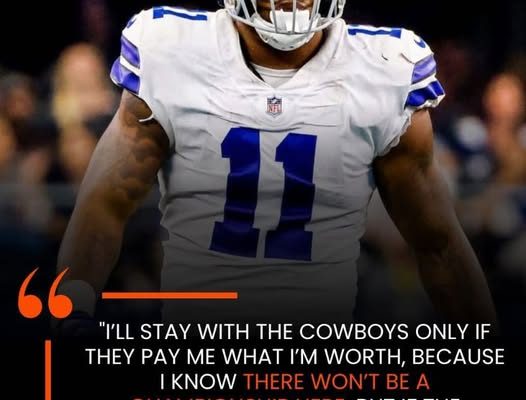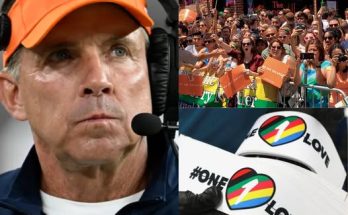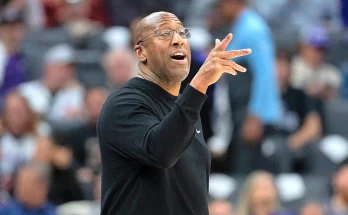In the midst of one of the most unpredictable offseasons in recent NFL history, a Cowboys superstar has left fans and analysts alike buzzing with speculation after dropping a cryptic hint regarding his potential future with the Denver Broncos. The revelation, subtle yet loaded with implications, comes at a time when trade rumors and contract negotiations are dominating the headlines, creating a storm of uncertainty surrounding some of the league’s most high-profile players.
Sources close to the situation report that the player, whose identity remains closely guarded in official statements, has been quietly exploring options that could dramatically shift the balance of power in the NFC and AFC alike. While no formal request for a trade has been filed, nor any public indication of dissatisfaction with the Cowboys organization, the suggestion of a possible move to Denver has sent shockwaves through both fan bases and pundit circles.
The Cowboys, long recognized for their aggressive approach in talent acquisition and retention, now face a complex calculus in weighing the potential departure of one of their marquee athletes. On one hand, the team has a deep roster and a culture of resilience that could absorb the loss; on the other hand, letting go of a player of this caliber would represent a seismic shift in team dynamics, strategy, and public perception. Cowboys general manager strategies have historically emphasized maintaining a strong core while supplementing with savvy acquisitions, but the current climate suggests that even a franchise known for stability is not immune to turbulence.
Meanwhile, the Denver Broncos have been no strangers to similar drama in recent years. The organization has consistently sought marquee talent capable of elevating the team into playoff contention, often engaging in high-profile trades and contract negotiations to secure the right mix of skill and leadership. If the rumored move were to materialize, it would mark a significant moment in the franchise’s ongoing evolution, potentially signaling a renewed commitment to aggressive roster development and championship aspirations.
Analysts are quick to note that the cryptic nature of the superstar’s remarks leaves room for multiple interpretations. Some argue that the statement is merely a negotiating tactic, designed to leverage the player’s value within the Cowboys organization or on the open market. Others suggest that it represents genuine interest in a change of scenery, perhaps motivated by the desire to compete in a different system or under a new coaching philosophy. The nuance of this situation underscores the delicate interplay between player agency, team strategy, and league-wide ramifications in professional sports.
Trade rumors, especially those involving top-tier talent, have a tendency to dominate not only sports media but also social platforms, where fan theories and speculation flourish at an unprecedented pace. In this case, the combination of a superstar hint, the backdrop of ongoing contract negotiations, and the history of both franchises involved has created a perfect storm of conjecture. Social media reactions range from disbelief to excitement, with many fans envisioning scenarios in which the player could dramatically alter the trajectory of the Broncos’ season. Conversely, Cowboys fans are grappling with the prospect of losing a cornerstone talent and the uncertainty surrounding the team’s strategic response.
The timing of this hint is particularly significant. With free agency and the NFL Draft approaching, teams are preparing to make decisions that will define their competitive prospects for years to come. Contract negotiations are often a delicate dance, balancing financial considerations with player satisfaction, team chemistry, and long-term vision. In the case of a high-profile superstar, the stakes are exponentially higher. Teams must carefully weigh salary cap implications, roster composition, and the potential impact on team culture. A move to Denver would not only involve a financial commitment but also a recalibration of the team’s strategic direction, potentially affecting everything from offensive schemes to marketing and fan engagement.
From a broader perspective, the scenario highlights the evolving nature of player empowerment in the NFL. Unlike past eras, when athletes often had limited influence over their destinies, today’s stars possess a combination of leverage, public visibility, and agency that enables them to shape conversations about their careers. The ability to hint at potential destinations, whether serious or strategic, represents a form of soft power that can influence negotiations, media narratives, and public perception. This dynamic adds a layer of complexity to traditional management practices, requiring front offices to navigate not only performance metrics and contracts but also the optics of public statements and the nuanced signals sent through social channels.
For Denver, the prospect of acquiring a Cowboys superstar could have immediate and long-term implications. On the field, the addition of top-tier talent could fill critical gaps, complement existing stars, and elevate overall team performance. Off the field, such a move could energize the fan base, boost ticket sales, and enhance the team’s brand visibility. The potential synergy between the player’s skill set and the Broncos’ current roster composition is a topic of intense debate among analysts, who are projecting various scenarios to assess both risk and reward. While the financial cost and draft capital involved in such a trade would be considerable, proponents argue that the potential competitive upside justifies aggressive pursuit.
Conversely, the Cowboys face a critical juncture. Retaining a superstar of this caliber is not merely a matter of honoring existing contracts; it requires active engagement, reassurance, and the demonstration of organizational vision. The team must communicate its long-term commitment to winning, highlight opportunities for the player’s personal and professional growth, and ensure alignment with coaching strategies and team culture. Failure to address these factors could result in a destabilizing departure, affecting not only on-field performance but also public perception and internal morale. In essence, the Cowboys must balance pragmatism with persuasion, leveraging both organizational strengths and relational dynamics to navigate a high-stakes situation.
It is also important to recognize that the NFL ecosystem operates in a highly interconnected fashion. Moves involving star players generate ripple effects across the league, influencing trade markets, free agency decisions, and competitive strategies. Rival teams monitor such developments closely, adjusting their own plans to capitalize on opportunities or mitigate risks. Agents and advisors play a critical role in shaping the narrative, advising players on timing, messaging, and negotiation tactics. The complexity of these interactions underscores why even a cryptic hint can have outsized effects, generating conversations and calculations that extend far beyond the immediate franchises involved.
Amidst this maelstrom, fans are left to speculate, debate, and imagine the potential outcomes. Will the Cowboys successfully retain their superstar, reinforcing their status as a dominant force in the NFC? Or will the Broncos emerge as a new destination, reshaping the competitive landscape and introducing a fresh narrative to the AFC? The answers remain uncertain, but the intrigue itself is a testament to the star power involved, the strategic importance of high-profile athletes, and the intensity of modern NFL media ecosystems.
Ultimately, this unfolding story reflects the convergence of performance, business, and narrative in professional sports. It is not solely about athletic ability or on-field achievements; it is equally about timing, messaging, leverage, and perception. Every remark, every hint, and every negotiation carries significance, influencing outcomes that extend from locker rooms to boardrooms to living rooms filled with passionate fans. The Cowboys superstar’s cryptic suggestion about a potential Broncos future embodies this complexity, serving as a focal point for speculation, analysis, and strategic maneuvering that will likely dominate headlines for weeks to come.
As both franchises navigate the next steps, observers will be closely monitoring official statements, trade chatter, and contractual developments. Analysts will dissect potential alignments, salary cap implications, and performance projections, while fans will continue to speculate on social media platforms, sharing scenarios ranging from optimistic dreams to cautious warnings. The combination of uncertainty, talent, and timing ensures that this story will not fade quickly; instead, it is poised to become a defining narrative of the NFL offseason, illustrating the intricate interplay between superstar agency, team strategy, and league-wide dynamics.
In conclusion, the Cowboys superstar’s hint about a potential move to the Denver Broncos represents more than a simple offhand comment. It is a catalyst for discussion, negotiation, and speculation, highlighting the complex ecosystem of professional football, where talent, business, and perception intersect. While the final outcome remains unknown, the implications are profound, touching on team strategy, player empowerment, and league-wide competitiveness. As the offseason progresses, all eyes will remain on the Cowboys and Broncos, waiting to see whether a bold move will materialize, forever altering the NFL landscape and setting the stage for what promises to be a dramatic and transformative period in professional football history.


